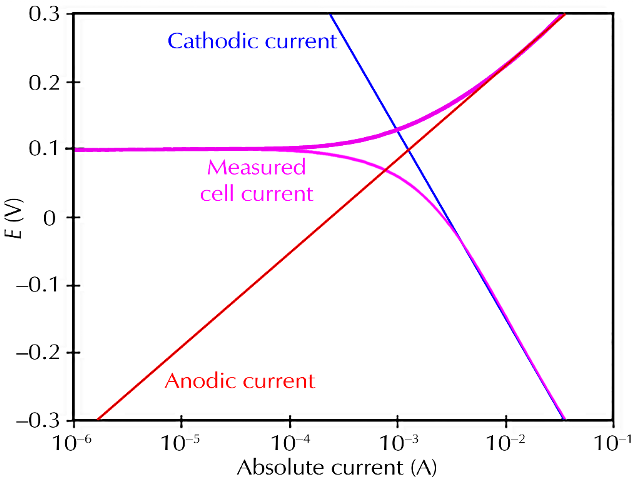
Nearly all metal corrosion occurs via electrochemical reactions at the interface between the metal and a electrolyte solution. A thin film of moisture on a metal surface forms the electrolyte for atmospheric corrosion. Wet concrete is the electrolyte for reinforcing rod corrosion in bridges. Although most corrosion takes place in water, corrosion in non-aqueous systems is not unknown.
Corrosion normally occurs at a rate determined by an equilibrium between opposing electrochemical reactions. The first is the anodic reaction, in which a metal is oxidized, releasing electrons into the metal. The other is the cathodic reaction, in which a solution species (often O2 or H+) is reduced, removing electrons from the metal. When these two reactions are in equilibrium, the flow of electrons from each reaction is balanced, and no net electron flow (electronic current) occurs. The two reactions can take place on one metal or on two dissimilar metals (or metal sites) that are electrically connected.
The following figure illustrates this process. The vertical axis is potential and the horizontal axis is the logarithm of absolute current. The theoretical current for the anodic and cathodic reactions are shown as straight lines. The curved line is the sum of the anodic and cathodic currents. When you sweep the potential of the metal, you measure the current. The sharp point in the curve results from the use of a logarithmic axis. It is actually the point where the current gets very small prior to changing sign.

The potential of the metal is the means by which the anodic and cathodic reactions are kept in balance. Refer to the previous figure. Notice that the current from each half-reaction depends on the electrochemical potential of the metal. Suppose the anodic reaction releases too many electrons into the metal. Excess electrons shift the potential of the metal more negative, which slows the anodic reaction and speeds up the cathodic reaction. This reaction, by Le Châtelier's Principle, counteracts the initial perturbation of the system.
In the DC Corrosion software, the equilibrium potential assumed by the metal in the absence of electrical connections to the metal is called the open-circuit potential, Eoc.
The value of either the anodic or cathodic current at Eoc is called the corrosion current, Icorr. If we could measure Icorr, we could use it to calculate the corrosion rate of the metal. Unfortunately Icorr cannot be measured directly. However, it can be estimated using electrochemical techniques. In any real system Icorr and corrosion rate are a function of many system variables, including type of metal, solution composition, temperature, solution movement, metal history, and so on.
The above description of the corrosion process does not say anything about the state of the metal surface. In practice, many metals form an oxide layer on their surface as they corrode. If the oxide layer inhibits further corrosion, the metal is said to passivate. In some cases, local areas of the passive film break down, allowing significant metal corrosion to occur in a small area. This phenomenon is called pitting corrosion, or simply pitting.
Because corrosion occurs via electrochemical reactions, electrochemical techniques are ideal for the study of the corrosion processes. In electrochemical studies a metal sample a few cm² in surface area is used to model the metal in a corroding system. The metal sample is immersed in a solution typical of the metal's environment in the system being studied. Additional electrodes are immersed in the solution, and all the electrodes are connected to a device called a potentiostat. A potentiostat allows you to change the potential of the metal sample in a controlled manner.
With the exception of Open Circuit Potential vs Time and Galvanic Corrosion techniques, all of the DC Corrosion standard techniques use the potentiostat to perturb the equilibrium corrosion process. When the potential of a metal sample in solution is forced away from Eoc, we call it polarizing the sample. The response (current or voltage) of the metal sample is measured as it is polarized. The response is used to develop a model of the sample's corrosion behavior. Both controlled potential (potentiostatic) and controlled current (galvanostatic) polarization are useful. When the polarization is done potentiostatically, current is measured, and when it is done galvanostatically, potential is measured.
Suppose we use the potentiostat to force the potential of a metal anodically (towards positive potentials) from Eoc. In the previous figure, we are moving towards the top of the graph. This increases the rate of the anodic reaction and decrease the rate of the cathodic reaction. Because the anodic and cathodic reactions are no longer balanced, a net current flows from the electronic circuit into the metal sample. The sign of this current is positive by convention. The potentiostat accurately measures the current. If we take the potential far enough from Eoc, the current from the cathodic reaction is negligible, and the measured current is a measure of the anodic reaction alone. In the previous figure, notice that the curves for the cell current and the anodic current lie on top of each other at positive potentials. Conversely, at strongly negative potentials the cell current is dominated by the cathodic current.
In some cases as we vary the potential, we first passivate the metal, then cause pitting corrosion. Analysis of a curve plotting the measured current versus time or potential may allow us to determine Icorr at Ecorr, the tendency for passivation to occur, or the potential range over which pitting will occur.